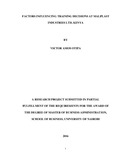| dc.description.abstract | Differentiation on the basis of the skills, knowledge, and motivation of the workforce is becoming increasingly important as organizations attempt to compete in a global economy. Training refers to a systematic approach to learning and development to improve individual, team, and organizational effectiveness. There is documented evidence that training activities have a positive impact on the performance of individuals and teams. Training activities can also be beneficial regarding other outcomes at both the individual and team level (e.g., attitudes, motivation, and empowerment). Unlike the newly industrializing economies of South East Asia such as Indonesia, Malaysia, Thailand, Singapore and Korea,Kenya’s manufacturing sector, despite its potential, has not been dynamic enough to function as the engine for growth for the Kenyan economy. Many reasons have been cited for this; top among them the lack of technical skills among workers in the manufacturing sector. Human resource managers consider the following major categories when making training decision: worker characteristics(education, age, ability, sex, tenure, motivation and ethnicity), job characteristics (occupation, earnings, casual employment and hours worked), enterprise characteristics(industry, firm size, sector, human resource policies, technological change andthe self-employed and employers) and sociopolitical and economic environment(competition, unemployment, legislation and national characteristics).
.This was a case study using qualitative approach. The objective of this study was to establish the factors influencing training decisions at Malplast Industries Ltd. The study targeted all the top and middle level managers of the company. There are 6 top level managers and 9 heads of departments. The total number is 15 which was the target population. The study used census since the population was small. Primary data was collected using semi-structured interviews. Data was analyzed using the content analysis technique. The study found that educational qualification was the employee characteristic that had the greatest influence on training decisions. It was also found that occupation was the job characteristic with the greatest influence on training decisions. On social economic and political factors, competition was found to have the greatest influence on training decisions while technological changes was the enterprise characteristic with greatest influence on training decisions. | en_US |



